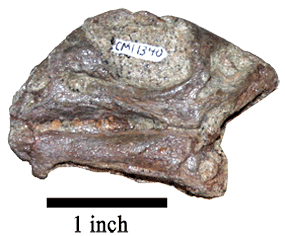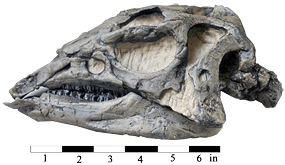
NPS/Bob Walters Tess Kissinger Dryosaurus elderae is a species of ornithopod dinosaur from the Late Jurassic of North America, found in the Morrison Formation. Dryosaurus means “oak lizard” in reference to the leaf shaped teeth. It is a plant eating dinosaur with a beak and teeth in the back of its mouth. It had five fingers on each hand. To escape predators Dryosaurus depended on its strong legs to quickly run away. 
Both adult and juvenile Dryosaurus skeletons and skulls have been found in the Carnegie Quarry. The adult skull is the most complete best preserved in the world. Dinosaur skulls are mostly hollow and made of thin bone that often breaks. Fine sediments compress the skull during burial to flatten it the way you might step on an empty tin can. These skulls may be preserved, but some of the 3-D structure is lost. The sand-sized sediments in the Carnegie Quarry allow the Dryosaurus to be preserved in great detail without being crushed. The mounted skeleton at the Carnegie Museum of Natural History is the most complete found in Western Hemisphere and the only mounted Dryosaurus elderae in the world. 
The juvenile skull found is the most complete juvenile Dryosaurus skull ever found. Juvenile dinosaurs in general are rare finds. Since the bones are smaller and more fragile than those of the adults, they are easily broken or washed away in rivers before they are fossilized. Although most of the body was found, only the skull is on display. |
Last updated: April 26, 2023
